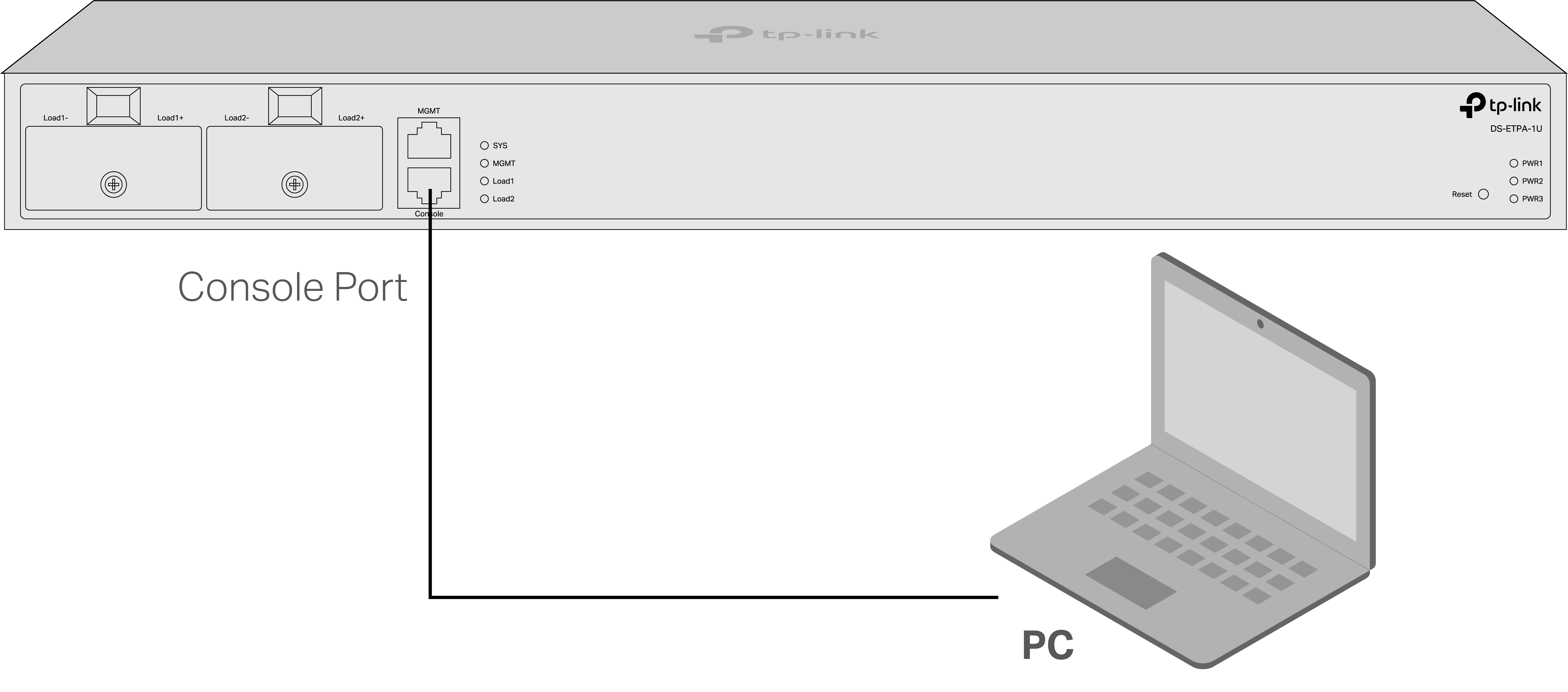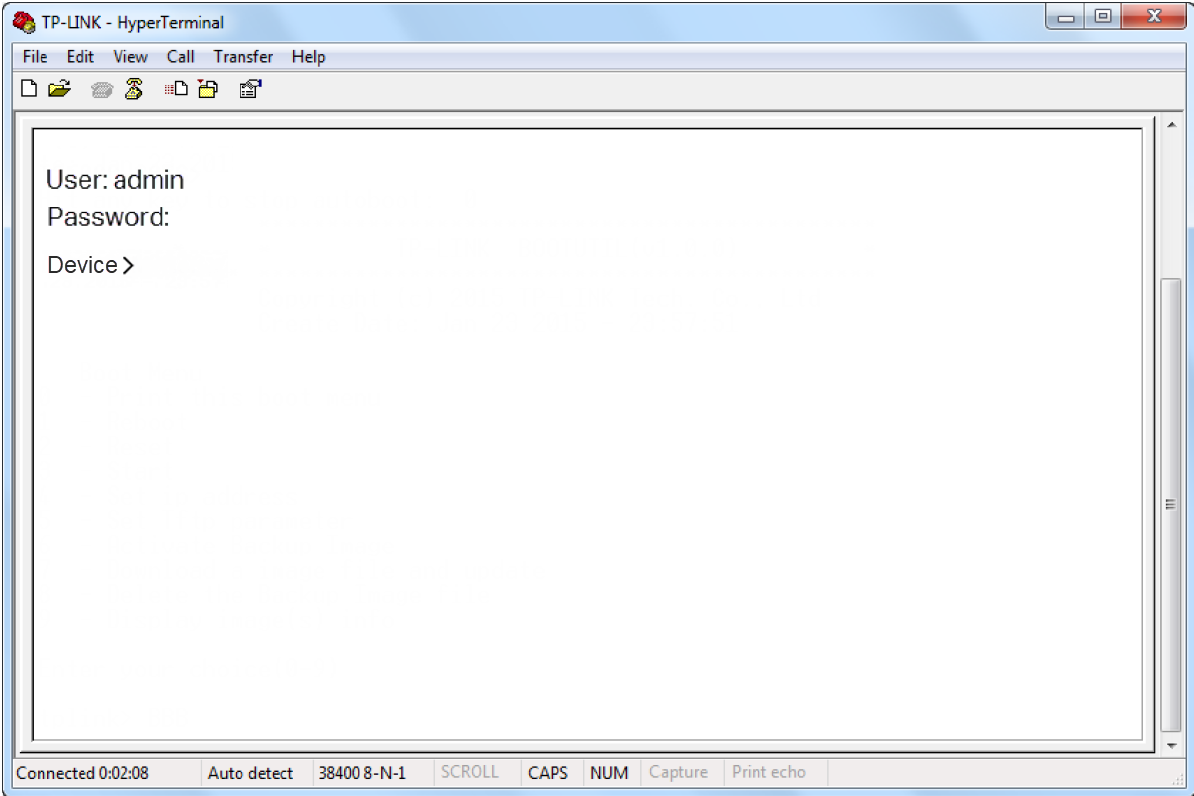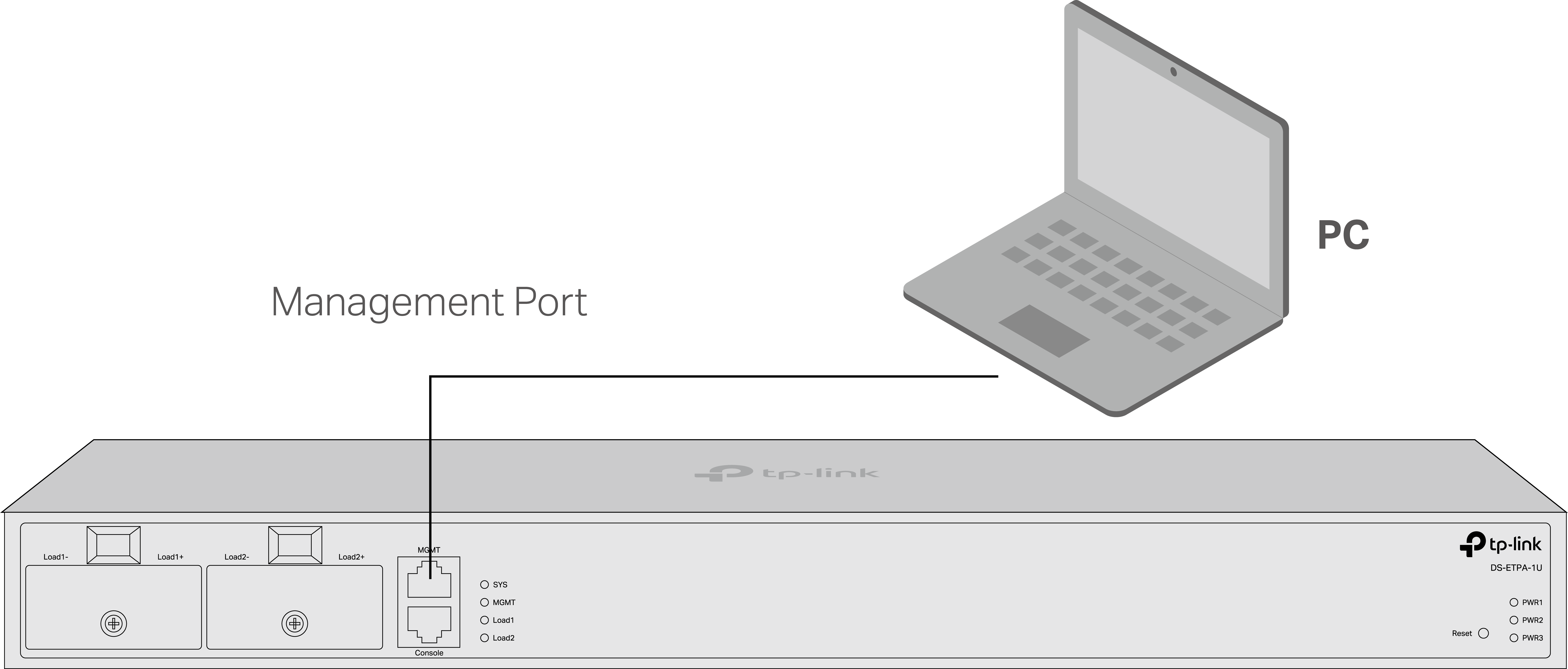Table of Contents
DS-ETPA-1U_CLI Guide
Preface
This Guide is intended for network administrator to provide referenced information about CLI (Command Line Interface). The device mentioned in this Guide stands for DeltaStream Chassis Embedded Telecom Power without any explanation. Some models featured in this guide may be unavailable in your country or region. For local sales information, visit https://www.tp-link.com.
Using the CLI
Access the CLI
You can log on to the device and access the CLI by the following two methods:
- Logon Via the Console Port.
- Logon By Telnet.
Via the Console Port
Take the following steps to log on to the device via the Console Port.
1. Connect the device's Console port to the management PC using an RJ45 console cable.

2. Start the terminal emulation program (such as the Hyper Terminal) on the PC and configure the terminal emulation program as follows:
- Baud rate: 115200 bps
- Data bits: 8
- Parity: none
- Stop bits: 1
- Flow control: none
3. Type the Username and Password in the Hyper Terminal window. The default value for both of them are admin. Press Enter in the main window and “Device>” will appear indicating that you have successfully logged in to the device and you can use the CLI now.

Note: The first time you log in, change the password to better protect your network and devices.
Logon by Telnet
To log on to the device via a Telnet connection, please take the following steps:
1. Connect the device's MGMT port to the management PC.
Connect the MGMT port to the management PC using an Ethernet cable. Set the IP address of the PC as 192.168.0.x/24 (x is a number between 2 and 254). Open the terminal on the PC. Then type in “telnet 192.168.0.1” and press Enter.


Note: The first time you log in, change the password to better protect your network and devices.
Conventions
Format Conventions
The following conventions are used in this Guide:
-
Items in square brackets [ ] are optional
-
Items in braces { } are required
-
Alternative items are grouped in braces and separated by vertical bars. For example: speed {10 | 100 | 1000 }
-
Bold indicates an unalterable keyword. For example: show logging
-
Normal Font indicates a constant (several options are enumerated and only one can be selected). For example: mode {dynamic | static | permanent}
-
Italic Font indicates a variable (an actual value must be assigned). For example: bridge aging-time aging-time
Special Characters
ou should pay attentions to the description below if the variable is a character string:
-
These six characters ” < > , \ & cannot be input.
-
If a blank is contained in a character string, single or double quotation marks should be used, for example ’hello world’, ”hello world”, and the words in the quotation marks will be identified as a string. Otherwise, the words will be identified as several strings.
Parameter Format
Some parameters must be entered in special formats which are shown as follows:
-
MAC address must be entered in the format of xx:xx:xx:xx:xx:xx.
-
One or several values can be typed for a port-list or a vlan-list using comma to separate. Use a hyphen to designate a range of values, for instance, 1/0/1, 1/0/3-5, 1/0/7 indicates choosing port 1/0/1, 1/0/3, 1/0/4, 1/0/5, 1/0/7.
Menu Commands
Description
The menu command is used to view the supported CLI commands.
Syntax
?
Example
View supported CLI commands:
DS-EPTA-1U# ?
Set Commands
The set command is used to configure the parameters of the chassis power supply, including the current alarm threshold for each load, the power alarm threshold, and the priority of the two load outputs. An alarm will be triggered if the current or power of a load exceeds the specified thresholds. Note that if the alarm power set for a single load exceeds the total power that the device can provide, the alarm value will be limited to the total power available from the device.
Current
Description
The warning-current command is used to specify current alarm threshold for each load.
Syntax
set {load1|load2} waring-current current-value
Parameter
waring-current——The waring current value.
Example
Specify the alarm current of Load 1 to 25A:
DS-EPTA-1U# set load1 waring-current 25
Power
Description
The warning-load command is used to specify power alarm threshold for each load.
Syntax
set {load1|load2} waring-load load-value
Parameter
waring-load——Alarm power of load.
Example
Specify the alarm power of load 1 to 1000W:
DS-EPTA-1U# set load1 waring-load 1000
Priority
Description
The priority command is used to specify priority for each load.
Syntax
set high-priority {load1|load2}
Example
Specify higher priority to load 1:
DS-EPTA-1U# set high-priority load1
Show Commands
The show command displays essential information about the power supply, such as the voltage and current of the supplied AC power, power status, hardware version, software version, and the inlet and outlet temperatures. It also provides key details about the power output load. Additionally, this command allows you to view the device's IP address, MAC address and SN (serial number).
Power
Description
The show power command is used to display power information of the device.
Syntax
show power
Example
Display the power information:
DS-EPTA-1U# show power
IP
Description
The show ip command is used to display ip address of the device.
Syntax
show ip
Example
Display the ip address:
DS-EPTA-1U# show ip
System-info
Description
The show system-info command is used to display system information of the device.
Syntax
show system-info
Example
Display the power information:
DS-EPTA-1U# show system-info
Reset Commands
The rest command is used to clear the user-configured parameters, including the username and password set by the user. The device will restart up clearing.
Description
The reset command is used to clear the user-configured parameters.
Syntax
reset
Example
Clear all configurations and restart the device:
DS-EPTA-1U# reset
MCU-Version Commands
Description
The mcu-version command is used to get the software for the currently working mcu.
Syntax
mcu-version
Example
Obtain the firmware version of the mcu :
DS-EPTA-1U# mcu-version
Firmware Commands
Description
The firmware command is used to upgrade the backup image of the mcu via TFTP server connection. The uploaded file will replace the backup image and the device will automatically boot from the new image upon successful upgrade.
Syntax
firmware ipaddress ip-addr filename name
Parameters
ip-addr ——IP Address of the TFTP server, for example 192.168.0.1
name ——Specify the name for the firmware file
Example
Upgrade backup image via firmware.bin, with the TFTP server's IP address set to 192.168.0.146. The device will not lose power during upgrade and the device will restart upon the upgrade is complete:
DS-EPTA-1U# firmware ipaddress 192.168.0.146 filename firmware.bin
IP-Address
Description
The IP Address command is used to configure static IP address for the device. The no command is used to delete this configuration. The device obtains an IP address via DHCP service by default. When static IP is configured, the specified IP will take effect, and the DHCP function will be disabled.
Syntax
ip-ipaddress ip-addr ip-mask gateway
Parameters
ip-addr ——Specified satic IP Address, for example 192.168.0.10
ip-mask ——The subnet mask for the IP address
gateway——The gateway for the IP address
Example
Specify the device's IP to 192.168.0.146, with subnet mask is 255.255.255.0 and gateway is 192.168.0.1:
DS-EPTA-1U# ip-address 192.168.0.60 255.255.255.0 192.168.0.1
FAN-Speed
Description
The fan-speed command is used to configure the fan speed for the three pluggable power supply modules, with five speed levels (1-5) available. A higher number indicates a higher fan speed. The fan speed defaults to following the power supply's speed policy.
Syntax
fan-speed pwr rank
Parameters
pwr ——Specify the power supply that needs fan speed adjustment. pwr1, pwr2, and pwr3 indicate the fan speeds of power supplies 1, 2, and 3 respectively.
rank ——The fan speed level, 1 is the lowest and 5 is the highest.
Example
Specify fan speed level for power supply 1 to 3:
DS-EPTA-1U# fan-speed pwr1 3
Debug Commands
Description
The debug command is used to view the alarms or abnormal events related to power load. No information will be displayed if there are no abnormal events.
Syntax
debug log
Example
View the recently triggered saved exception events:
DS-EPTA-1U# debug log
Logout Commands
Description
The logout command is used to log out. Once logged out, you will need to verify your username and password again to access CLI commands.
Syntax
log out
Example
Log out the current account:
DS-EPTA-1U# logout
Telnet Commands
Note: It is recommended to use Busybox telnet or Cygwin telnet client for better and stable connection.
Enable
Description
The telnet enable command is used to enable the telnet remote service feature. when the service is enabled, you can log in remotely via specified telnet server.
Syntax
telnet enable
Example
Enable telnet remote service:
DS-EPTA-1U# telnet enable
Disable
Description
The telnet disnable command is used to disable the telnet remote service feature.
Syntax
telnet disable
Example
Disable telnet remote service:
DS-EPTA-1U# telnet diable